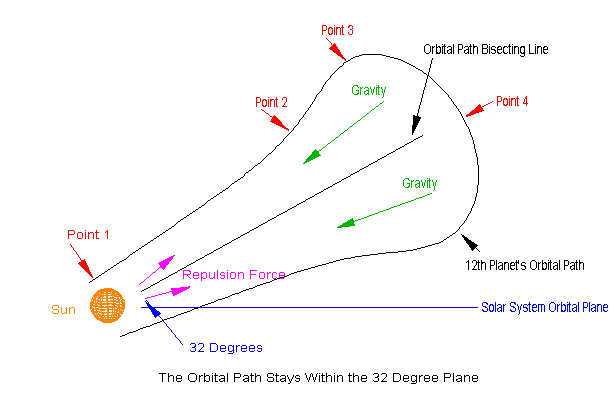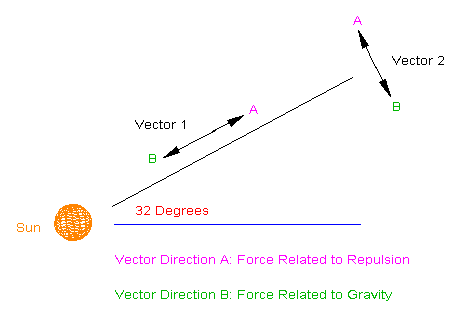
Forces Acting on the 12th Planet from Point A to E

A Breakdown of Forces Applied at Points 1 to 4 will be Represented by Vectors:

Point 1: As the 12th planet pierces the elliptical plane
and passes the Sun several forces come into play. Its approach
velocity allows closer pass to the Sun inside the point of repulsion (the point
where the force gravity and repulsion are equal keeping interacting masses
apart). There is gravity pulling the 12th planet towards the Sun, the
repulsion force pushing outwards and to a very small degree, the Dark One
pulling from the rear. The repulsion force greater than the attractive force
gravity within the orbit of Saturn pushes the 12th planet out of the
solar system. Velocities in vectors 1 & 2 are pointed to A both at their
maximums. This forms a smooth line slightly outwards from the orbital bisect
line for a uniform segment of T (Time).
Point 2: In this sector of the orbital path, velocity decreases in
the direction A at a greater rate in vector 1 than vector 2 due to the gravity
sources of the Sun and dark One and the orbit takes on a parabolic outward curve
during the same interval T.
Point 3: At this point the force of gravity as eroded all velocity
due to the repulsion force perpendicular to the orbital bisecting line. In
vector 2 all forces are neutral with no direction. In vector 1, velocity has
slow significantly. As the 12th planet proceeds past this point,
gravity bends the orbit inward and vector 2 takes on a new direction towards B.
Point 4: Here at the 12th
planetís maximum distance from the Sun, velocity in vector 1 has reached zero
as gravity from both stellar objects halts forward progress. Gravity only
provides movement in the direction B along vector 2 as momentum carries it pass
the orbital bisecting line. It is gravity again that stops forward progress in
vector 2 and the inbound path mirrors the outbound.
All Rights Reserved: © Copyright 2003